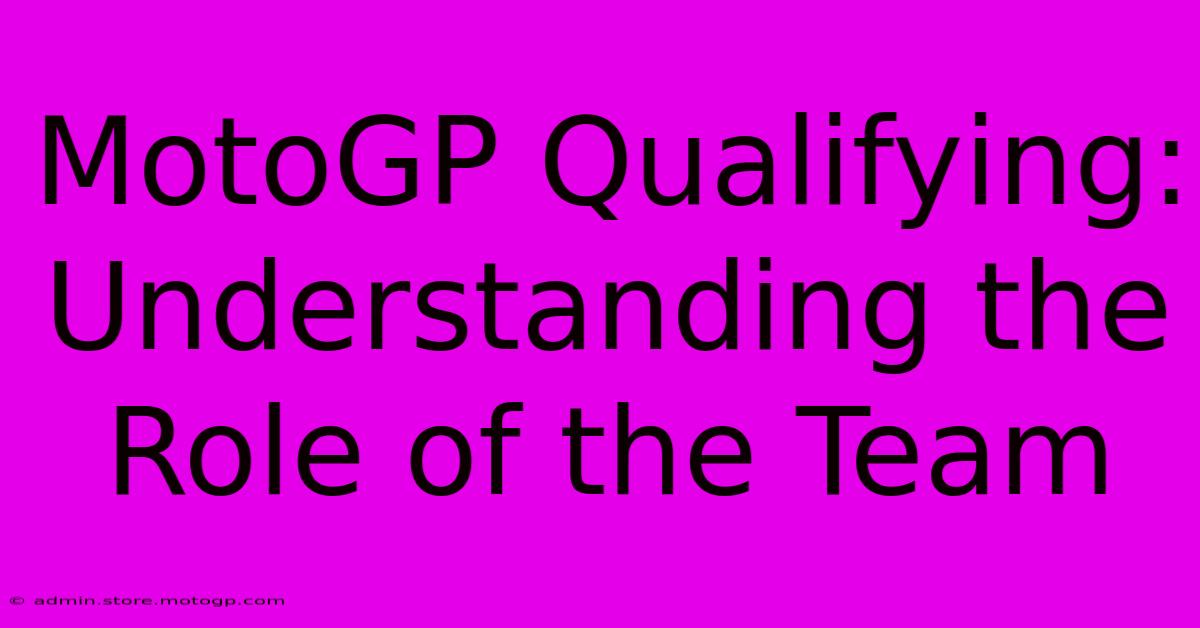MotoGP Qualifying: Understanding The Role Of The Team

Table of Contents
MotoGP Qualifying: Understanding the Role of the Team
MotoGP qualifying is a high-pressure, meticulously planned operation, far exceeding a simple rider-against-rider battle. The team plays a pivotal, multifaceted role, impacting every aspect of a rider's performance and ultimately, their starting grid position. This article delves into the crucial contributions of the team, revealing the intricate choreography behind the scenes of a qualifying session.
The Pre-Qualifying Preparations: Setting the Stage for Success
Before a wheel even turns on the qualifying track, the team's groundwork is already laid. This crucial pre-qualifying phase involves several key elements:
1. Data Analysis and Strategy:
The team meticulously analyzes data from previous practice sessions, focusing on:
- Track conditions: Understanding tire wear, optimal lines, and the influence of weather plays a crucial role in strategy formulation.
- Rider feedback: The rider's input on bike setup, handling, and braking points is invaluable. This provides insight into potential improvements and areas needing attention.
- Competitor analysis: Studying the performance and strategies of rival teams helps determine the best qualifying approach.
Based on this data, the team develops a detailed qualifying strategy, including tire choices, fuel loads, and planned session approaches (e.g., focusing on a single fast lap or multiple consistent laps).
2. Bike Setup and Fine-tuning:
The motorcycle itself is a crucial aspect of qualifying performance. The team meticulously fine-tunes the bike based on the collected data, focusing on aspects like:
- Suspension: Adjustments are made to optimize handling for the track and the rider's style.
- Aerodynamics: Fine-tuning aerodynamic components can make significant differences in top speed and stability.
- Engine mapping: Specific engine maps are developed to maximize power and torque delivery throughout the track.
- Electronics: Advanced electronics systems are adjusted for optimal traction control, anti-wheelie, and other performance-enhancing settings.
The Qualifying Session: Orchestrated Teamwork Under Pressure
The qualifying session itself is a whirlwind of activity, demanding precise coordination and seamless teamwork:
1. Pit Crew Efficiency:
The pit crew plays a critical role, ensuring swift and precise tire changes and mechanical adjustments between runs. Every second counts, and their efficiency directly impacts the rider's ability to improve lap times. A well-trained, synchronized pit crew can be the difference between a front-row start and a mid-grid position.
2. Real-time Data Acquisition and Feedback:
During the session, the team continuously monitors the rider's performance, collecting data on speed, acceleration, braking, and other key metrics. This real-time feedback allows for instantaneous adjustments to the bike's settings between runs. Engineers analyze the data and communicate necessary changes to the rider and the pit crew.
3. Rider Support and Communication:
Effective communication between the rider and the team is paramount. The rider relays information about bike feel, tire performance, and any issues encountered. The team, in turn, provides the rider with crucial feedback and makes strategic adjustments to the bike or race plan based on that information. Clear, concise communication under intense pressure is crucial to success.
4. Strategic Decisions During Qualifying:
The team must make strategic decisions throughout the session, considering factors like tire wear, track evolution, and competitor performance. These decisions might involve changing the strategy midway through the session, adjusting the fuel load for the final run, or deciding to use a different tire compound.
Post-Qualifying Analysis and Preparation for the Race
Even after the qualifying session concludes, the team's work isn't finished. They immediately begin analyzing the data from the qualifying runs to identify areas for improvement and to refine their strategy for the race. This includes reviewing the rider's performance, identifying any mechanical issues, and predicting track conditions for the race.
In conclusion, MotoGP qualifying isn't just about the rider's skill; it's a testament to the collaborative effort of the entire team. From meticulous pre-qualifying preparation and precise execution during the session to post-qualifying analysis and race strategy refinement, every member plays a vital role in determining the rider's starting position and ultimately, their chances of success in the race. The synergy and precision of the team are as crucial to the outcome as the rider's skill and talent themselves.

Thank you for visiting our website wich cover about MotoGP Qualifying: Understanding The Role Of The Team. We hope the information provided has been useful to you. Feel free to contact us if you have any questions or need further assistance. See you next time and dont miss to bookmark.
Featured Posts
-
Bike Racing On Tv Get Your Heart Racing
Feb 18, 2025
-
Moto Gp Qualifying Results Your Guide To The Starting Lineup
Feb 18, 2025
-
Cota Parking Lot Map Download Now
Feb 18, 2025
-
Cotas Upcoming Events Plan Your Trip Now
Feb 18, 2025
-
Malaysia Moto Gp A Must See For Racing Fans
Feb 18, 2025
